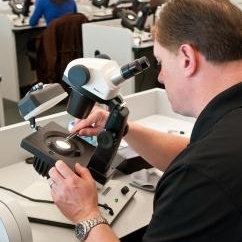Articles and News
CRIMESTOPPERS TAP GIA TO SOLVE THEFTS, MURDER, MORE April 11, 2012 (0 comments)

Carlsbad, CA—More than $1.5 billion of jewelry and precious metals were stolen in the U.S. in 2010, with a recovery rate of only around 4.2%, according to the Uniform Crime Report issued by the FBI. To help combat gem and jewelry-related crime, law enforcement turned to GIA (Gemological Institute of America) for expertise and assistance.
Last month, 22 special agents and detectives from international law enforcement agencies completed a custom-designed intensive two week program at GIA to arm them with skills, knowledge and network to help successfully identify and recover gems and jewelry involved in criminal cases.
Law enforcement officers from Canada, Hong Kong, Malaysia and South Africa joined representatives from 13 U.S. cities, including police officers, FBI agents, and Homeland Security investigators, to learn how advanced gemological information can help solve international gem and jewelry crimes.
The experienced professionals received training in: the GIA-created 4Cs of diamond quality and their grading factors; tools of the trade including loupes and microscopes; an industry overview outlining the role of diamonds in the marketplace; synthetics, imitations and treatments; field identification of colored gemstones; how to read a GIA grading report; how jewelry is made; and breaking down stolen jewelry.
GIA and law enforcement both dedicate themselves to the people they serve, according to Special Agent Daniel McCaffrey, a 16-year veteran of the FBI. “A GIA education is indispensable. The information and practices I’ve learned give me a certain edge because I’m able to employ a more technical perspective,” he said. He's shown in the photo at the top of this page, working on coursework in a special custom-designed laboratory class for law enforcement.
“Our mission is to protect the public in gemstone and jewelry purchases,” said Donna Baker, president and CEO of GIA. “We’re pleased to have built a strong working relationship with law enforcement agencies around the world. By working together, we can help reduce gem-related crimes.”
The goals of the seminar were to teach practical gemology for use in investigations, and demonstrate how GIA resources are readily available to assist in criminal cases. The blend of national and international attendees added the crucial element of transnational cooperation. Representatives from mining countries such as Canada and South Africa brought their unique experience with crimes that occur at the source of gemstones; while others brought a consumer perspective.
In the 1980s, a database of diamonds and colored stones with GIA grading reports was started to assist law enforcement in identifying gemstones involved in crimes. Stones, even if they have been re-cut, can be identified in the system. Another way GIA can identify a stone is through a laser inscription. A police report with a certified English translation is required to utilize this system.
Criminal cases solved through the GIA database are not restricted to jewelry theft. McCaffrey described how identifying the stone in an engagement ring led to identification of a murder victim. Investigators were able to trace the ring back to the jeweler who sold the ring by flagging it in the database, which eventually led them to the victim’s family.
“Jewelry theft is often a gateway crime,” said FBI supervisory special agent Eric Ives, organized crime and major theft program manager. “These crimes are often associated with very sophisticated and sometimes violent international criminal enterprises involved in other criminal violations, including money laundering. The illicit proceeds from the trafficking of stolen jewelry are sometimes used to fund other criminal activities.”
GIA has supported and educated law enforcement for decades, say GIA officials, but the current intensive program began as a partnership between GIA and the Major Theft Program at FBI Headquarters in 2007. Through this collaboration, the training course was coordinated, the curriculum was developed, and attendees selected.
To learn more about GIA’s programs and offerings, visit www.gia.edu.







